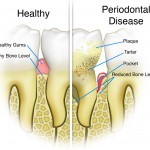
Periodontitis is very common being characterised by a microbially associated, host-mediated inflammation that results in loss of periodontal attachment and bone. Improved oral hygiene together with scaling and root planing (SRP) which aims to eliminate local irritating factors is the mainstay of treatment. However surgical intervention may be necessary to correct bone defects and grating with autografts, allografts or with synthetic alloplasts has been used. Tricalcium phosphates such as biphasic calcium phosphates and bioglass are alloplasts that have been used for sinus lift procedures, alveolar reconstructions and bone grafts in periodontal defects.
The aim of this review was to assess the clinical efficacy of tricalcium phosphates (-containing) biomaterials in the treatment of periodontal infra-bony defects compared to open flap debridement.
Methods
Searches were conducted in the Cochrane, Embase and the Medline/PubMed databases. Randomised Clinical Trials (RCTs), comparing the results of Tricalcium phosphate (TCP) (-containing) bone graft materials with open flap debridement with a follow-up period of at least six months were considered. Two reviewers screened and selected studies and extracted data. Study quality was assessed using the Jadad scale. The primary outcome was residual probing pocket depth (PPD)., secondary outcomes included changes in clinical attachment level (CAL), gingival recession (REC) and radiographic findings, i.e., radiographic percentage bone fill (PBF) in percentage (%) or linear bone gain (LBG) in millimetres (mm). A random effects meta-analyses was carried out.
Results
- 16 RCTs (11 parallel, 5 split mouth) involving a total of 616 patients were included.
- Sample sizes ranged from 12 to 177 patients.
- 7 RCTs scores 5 points on the Jadad scale with 2 studies having lower than 3 points.
- None of the studies reported any adverse events.
- 6 studies contributed to the meta-analysis comparing PPD and CAL at 6 and 12 months with a statistically significant benefits in favour of TCP at 6 and 12 months (see table).
| Pocket probing depth MD (95%CI) | Clinical attachment level MD (95%CI) | |
| 6 months | -0.47mm (-0.83 to -0.12) | -1.06mm (-1.76 to -0.46) |
| 12 months | -0.89mm (-1.54 to -0.23) | -1.25mm (-1.85 to -0.66) |
Conclusions
The authors concluded: –
According to the data presented and within the limitations of this systematic review, the application of tricalcium phosphate (-containing) materials may result in slight additional clinical improvements in terms of residual PPD, CAL and radiographically compared with open flap debridement alone in periodontal infra-bony defects.
Comments
The authors have searched 3 major databases and restricted their inclusions to RCTs. While following a standard review protocol they have used the Jadad scale to assess study quality which is an approach that is no longer recommended a point the authors note in the discussion. While the findings suggest improvements in PPD, CAL and radiographic outcomes only 6 of the studies contributed to the meta-analyses and the number of events and studies are small. Larger well-conducted and well reported RCTs of longer duration using common outcome sets to facilitate comparisons are needed. In particular to would be good to have international agreement of what are the minimally important clinical differences for periodontal outcomes measures.
Links
Primary Paper
Liu CC, Solderer A, Heumann C, Attin T, Schmidlin PR. Tricalcium phosphate (-containing) biomaterials in the treatment of periodontal infra-bony defects: A systematic review and meta-analysis. J Dent. 2021 Nov;114:103812. doi: 10.1016/j.jdent.2021.103812. Epub 2021 Sep 13. PMID: 34530060.
Other references
Dental Elf – 9th Dec 2020
Access flap procedures or subgingival debridement for periodontitis?
Dental Elf – 3rd Dec 2018
Periodontal infrabony defects: does autologous platelet concentrates (APC) improve surgical outcomes
Dental Elf – 24th Jul 2017
